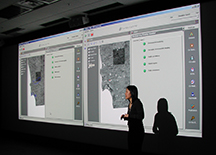
A role-playing simulation that enables emergency response officials to see how their decisions might play out in an event may be more important for bioterrorism than for other terrorist
scenarios because it involves release of a biological agent whose effects may take days or weeks to appear, researcher Lynn Yang (8114) said during a briefing of California site managers earlier this month.
The BioDAC (Biological Decision Analysis Center), simulates a release of anthrax or smallpox in an urban area (San Diego County). It was developed by Sandia researchers through the BioNet Program. Funded by the Department of Homeland Security and executed by the Department of Defense, BioNet was a year-long $23 million program to integrate civilian and military biodefense capabilities to facilitate the generation of a unified consequence management plan for a bioterrorism event. This includes jointly detecting and characterizing an event, leading to early phases of the response.
Sandia provided systems modeling and analysis of the population, medical response infrastructure, detection system, and key assets. Role-playing exercises help participants develop countermeasures and responses to an incident.
Ben Wu (8124) presented along with Lynn. He said there are approximately 100,000 military personnel at major Navy facilities in San Diego County, and timing of decisions reflects military mission priorities.
On the other hand, Lynn indicated that the civilian public health officers tend to be fairly conservative in part because of potential risks associated with responses like prophylaxis.
The first indication of an attack may be picked up as an anthrax reading on an air sampling detector in a civilian environmental monitoring system called BioWatch. The positive reading must be confirmed as a true positive. If confirmed, various decision alternatives need to be considered, including when (or if) the public should be notified and when (or if) antibiotic prophylaxis should be distributed.
Although the Navy would make decisions independently, both sides now appreciate the inherent interdependencies of their responses.
Using BioDAC, Navy and public health role players each had distinct views, including maps and other data showing resources and conditions impacting their role. The underlying scenario was visible to the analyst, which showed what Lynn called a “huge attack.” Antibiotic treatment can reduce the impact of the attack if administered in time.
Since the area has about 80,000 tourists a day, she said a scenario involving exposure to smallpox, which is contagious, would be more complicated. The disease would potentially spread beyond the county because large numbers of exposed travelers would leave the area before being aware of being infected.